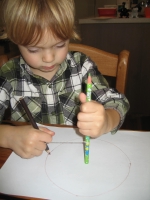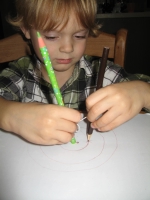From Appearance to Properties: 2.5
Supporting materials
- Related Progression Points
- Developmental Overview of Space (PDF - 32Kb)
- Developmental Overview of Structure (PDF - 35Kb)
Indicator of Progress

Success depends on students developing an appreciation that solids and shapes are identified and classified not just by what they look like, but by the properties that they have.
Initially, students identify shapes by an overall impression of what they look like. At this level, they start to be able to identify shapes and solids by reference to some of their properties. This is a long-term transition.
For more information see Changing conceptions of shapes (Level 4.25)
Illustration 1
A student at Level 1 will say "this is a circle" just because it looks round. However, a student working at progression point 2.5 will be able to identify some solids or shapes because they have the right properties. Such a student may say "this is a circle because all the points are the same distance from the centre" or "this is a cube because all the faces are squares, and all of the edges are the same length, and all of the angles are right angles." This very important geometric ability develops through the years.
Illustration 2

Examples of the types of tasks that would be illustrative of shape concepts, aligned from the Mathematics Online Interview:
- Question 54 (a – c) - Sorting shapes (and some triangles)
- Question 55 (a - b) - Identifying triangles
- Question 57 (a – c) - Visualise the hidden shape
Teaching Strategies
Developing a focus on properties rather than appearance is a long-term endeavour. The main teaching principles are:
- not to be satisfied with explanations in terms of visual appearance, but bring discussion around to geometric features whenever possible
- to develop students' geometric vocabulary so that they are able to share their observations
- to link properties of shapes and solids with their uses (e.g. boxes with right angles pack closely together, but cylindrical cans leave spaces).
At this level, the idea is to identify shapes and solids using many properties. When working towards levels 5 and 6 a minimum set of properties is used.
Activity 1: What is a circle? shows how students can learn about the defining property of a circle. This is an example of how students can learn about properties from the beginning.
Activity 2: How to draw a circle reinforces this defining property. By using it to draw circles students are also noting why a small modification results in a spiral not a circle. This is an example of how properties are used to explain and justify, even at this level.
Activity 3: Properties of three dimensional solids illustrates some of the geometric features that students at this level can observe and discuss. They may not yet have the formal vocabulary in place.
Activity 1: What is a circle?
This is a lesson from Japan, where it is used with very young students as a first lesson on circles.
Line the students up in a long line. The teacher (or a student with good ball skills) stands opposite the middle student. The teacher throws the ball to each student in turn, and if they drop the ball they are out. It does not take long before the students claim that this is an unfair game.
Students make suggestions about how to make the game fair. Often they suggest that they should form a square instead of the long line.
Play the game with the square. It does not take long before the students claim that this is an unfair game. Students at the corners are further away.
Students make suggestions about how to make the game fair. The teacher asks the students to stand so that they are all the same distance away. The term 'circle' is introduced to name the shape that they make.
Knowing that the points on a circle are all the same distance from the centre is much more powerful than just recognising a circle as a round shape. Using this property, students will later be able to identify circles, or parts of circles, in familiar places including:
- the space that a door needs to open
- the base of a cone (full circle), but also the curved part of the cone when flattened (all the points around the base have to be the same distance from the vertex so it is part of a circle)
- the shape of a pot made on a potter's wheel when clay is held at a fixed distance from the centre.

Activity 2: How to draw a circle
Students can draw circles:
- by finding a circular shape, such as the lid of a jar and drawing around it, or
- using a pencil on a length of string to make a set of points all the same distance from a fixed point
The first strategy encourages students to go by appearance alone. The second strategy uses the geometric property of a circle.
Have students try to draw a circle with a piece of string that wraps around the central pencil. Ask them why it is not a circle. As the string gets shorter, so the points get closer to the centre.
 |
 |
| A student using a pencil on a length of string to make a set of points all the same distance from a fixed point. |
A student drawing a circle with a piece of string that wraps around the central tether. As the string gets shorter the points get closer to the centre. |
Activity 3: Properties of three dimensional solids
In group discussion and individual writing, encourage students to focus on geometric features, not just appearance. This is applicable in identification, classification and also in construction. Students might note features such as the following, and also link them to uses of these shapes.
Note that not all of this vocabulary may be in place - students may use informal language.
Cube:
- all the faces are squares; all of the edges are the same length; all of the angles are right angles; the diagonals of the faces are the same length
- there are six faces, and the top is parallel to the bottom, and the side faces are parallel to each other
- when it stands on a face, the height is the same all the way along
- three edges meet at each vertex; three faces meet at each vertex etc.
- good for making dice because all the faces are the same, but it rolls better with rounded corners;
- no space is left when you pack them together because of the right angles.
Square Pyramid:
- all the faces are triangles except the base, which is a square; all of the edges going to the vertex are the same length
- there are five faces, eight edges, five vertices; all the triangular faces are the same size and shape
- when it is sliced parallel to the base, the slices are all squares but they become smaller as you move closer to the vertex
- three edges meet at each vertex except four meet at the top vertex
- it is still a pyramid if it is lying down - the 'base' can be tilted
- it is a very stable shape, because the base is much wider than the top.
